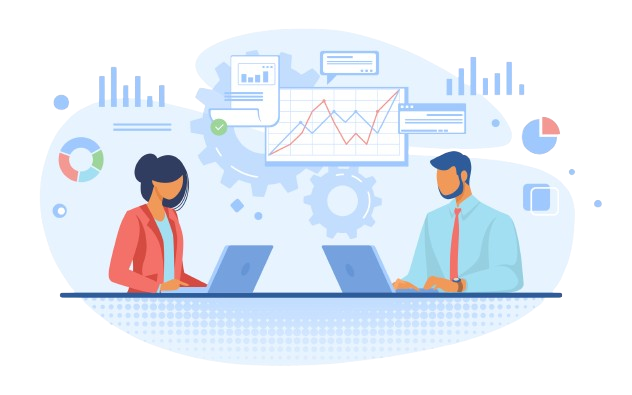Eliminate the inefficiencies, errors, and security risks of Excel-based business management by migrating to ERPNext’s integrated, automated, and secure ERP platform. Sigzen Technologies specializes in transforming scattered spreadsheets into ERPNext’s centralized system, delivering 40-60% reduction in manual data entry, elimination of version control nightmares, real-time collaboration capabilities, and comprehensive audit trails impossible with Excel. Experience ERPNext’s automated workflows, role-based access controls, real-time reporting, and scalable architecture that grows with your business beyond spreadsheet limitations.
Transform Spreadsheet Chaos into Streamlined ERP Excellence

Why Choose Sigzen Technologies for Excel or Spreadsheet to ERPNext Migration Services?
Step-by-Step Process to Migrating from Excel or Spreadsheet to ERPNext
Spreadsheet Inventory and Process Documentation
Catalog all Excel workbooks and spreadsheets used for business operations including financial tracking, inventory management, sales records, and operational reporting. Document spreadsheet-based workflows, formulas, macros, and interdependencies.
Business Process Analysis and Automation Planning
Analyze manual processes performed using spreadsheets identifying automation opportunities. Document current workflows including data entry, calculations, reporting, and information sharing to design automated ERPNext processes.
Data Structure Assessment and Database Design
Review Excel data organization including table structures, relationships, and calculation logic. Design ERPNext database architecture translating spreadsheet tables into properly structured DocTypes with defined relationships and validation rules.
Data Consolidation and Cleansing
Consolidate fragmented data scattered across multiple Excel files and shared drives. Execute comprehensive data cleansing standardizing formats, eliminating duplicates, correcting inconsistencies, and filling missing information.
ERPNext Configuration and Workflow Automation
Configure ERPNext modules replacing spreadsheet-based processes with automated database operations. Recreate Excel calculations as server-side logic, implement approval workflows replacing email-based processes, and establish automated reporting.
Data Import and Validation
Transform cleansed Excel data to ERPNext import formats, systematically import into appropriate modules, and validate data accuracy. Ensure relationships between entities are properly established in relational database structure.
Reporting and Dashboard Development
Recreate Excel-based reports as automated ERPNext reports and dashboards. Develop real-time analytics replacing manual report compilation, implement scheduled reports, and create executive dashboards providing instant visibility.
User Training and Change Management
Address paradigm shift from spreadsheet flexibility to structured database systems through comprehensive training. Demonstrate collaboration benefits, data integrity advantages, and automation capabilities encouraging user adoption.
Gradual Transition and Continuous Improvement
Implement gradual transition maintaining Excel temporarily for reference while teams adapt to ERPNext. Provide ongoing support addressing questions, continuously optimize workflows, and progressively eliminate spreadsheet dependencies.
Get a free no obligation quote now
Ready to unlock the full potential of ERPNext for your business? Contact us today for a no-obligation consultation to learn more about our ERPNext Consulting Services and discover how our expert ERPNext consultants can help you optimize your operations and drive growth with a customized, scalable ERP solution.
A Quick Comparison of Spreadsheets and ERPNext
Feature |
Excel/Spreadsheets |
ERPNext |
| Cost | Low initial cost but high hidden costs in time and errors | Free and open-source with professional capabilities |
| Customization | Manual formulas and macros prone to errors | Structured workflows with automated validations |
| Community | General user community; no business-specific support | Active ERP community with industry-specific expertise |
| Feature Set | Manual data entry across disconnected files | Integrated modules with automated data flow |
| Data Integrity | High risk of errors, version conflicts, and data loss | Centralized database with audit trails and version control |
| Focus | Individual task management | Enterprise-wide business process management |
| Collaboration | Limited multi-user capabilities; file sharing issues | Real-time multi-user collaboration with role-based access |
| Reporting | Manual report creation; time-consuming | Automated dashboards and customizable real-time reports |
| Automation | Limited macro-based automation | Comprehensive workflow automation and scheduled tasks |
| Scalability | Becomes unmanageable as business grows | Designed to scale with your business growth |
| Security | Minimal security; easy data loss | Role-based permissions, encryption, and secure backups |

Conclusion
Migrating from Excel to ERPNext transforms manual spreadsheet processes into automated database-driven operations, eliminating errors and inefficiencies. Sigzen Technologies guides organizations through paradigm shift from fragmented files to integrated ERP platform with real-time collaboration and data integrity. Businesses gain automated workflows, centralized data management, role-based access control, and audit trails impossible with spreadsheet limitations. Our structured approach ensures smooth user adoption, delivering immediate productivity gains through eliminated manual compilation, enhanced accuracy, superior collaboration capabilities, and scalable foundation supporting business growth beyond spreadsheet constraints.
Frequently Asked Questions
Why should we migrate from Excel spreadsheets to ERPNext?
Businesses migrate from Excel to ERPNext to overcome fundamental spreadsheet limitations threatening operational efficiency and growth. Excel-based operations suffer from constant data duplication across multiple disconnected files, version control nightmares with conflicting copies, manual calculation errors from complex formulas, limited collaboration forcing email attachments, lack of real-time business visibility, absence of audit trails and access controls, scalability constraints as data volumes grow, and error rates increasing with manual processes.
ERPNext provides centralized data storage eliminating duplication, automated workflows reducing manual entry by 40-60%, real-time multi-user collaboration, comprehensive audit logging, role-based permissions ensuring security, unlimited scalability, and integrated business processes spanning Accounting, Inventory, CRM, HR, and Manufacturing impossible with spreadsheets. Organizations transitioning from spreadsheets to ERP report improved data reliability, enhanced team collaboration, better-informed decision-making through real-time reporting, reduced errors through automation, and significant time savings from eliminated manual data entry.
How long does Excel to ERPNext migration take with Sigzen?
Migration timelines depend on spreadsheet complexity, data volume, number of Excel files, and business size. Small businesses with straightforward Excel-based operations typically complete migration in 4-8 weeks covering data consolidation, cleansing, import, and training. Mid-sized organizations with extensive interconnected spreadsheets, complex formulas, and multiple departments require 2-4 months ensuring thorough analysis, validation, and user adoption. Sigzen Technologies employs phased approaches starting with critical data like customers and inventory, progressively adding accounting, HR, and other functions reducing risks and enabling faster time-to-value. We provide detailed project timelines during assessment based on your specific spreadsheet environment, data quality, and transformation scope.
Can ERPNext replicate our complex Excel formulas?
Yes. Sigzen Technologies specializes in analyzing and replicating complex Excel logic in ERPNext. We document existing spreadsheet formulas, macros, conditional logic, lookup functions, and automated calculations understanding business rules embedded in Excel files. ERPNext provides multiple methods for recreating Excel logic including custom calculated fields for automatic computations, server scripts using Python for backend calculations, client scripts with JavaScript for interface logic, workflow automation for process-driven calculations, and custom reports matching Excel output formats.
We rebuild complex financial models, pricing calculations, inventory formulas, and business analytics previously managed in spreadsheets ensuring calculation consistency while leveraging ERPNext’s superior capabilities. Where Excel formulas become unnecessary due to ERPNext’s native automation, we recommend simplifications reducing maintenance complexity while preserving business value.
What happens to our historical Excel data?
Common migration challenges include data inconsistencies and mapping errors from mismatched field names or incorrect formats causing failed imports, which Sigzen addresses through CSV format validation, small test batches, and automated reconciliation scripts. Staff resistance to change requires comprehensive training programs emphasizing ERPNext’s advantages and hands-on practice environments. Complex customizations in Tally voucher types or reports need rebuilding in ERPNext using custom fields and scripts. Multi-company Tally setups require careful planning for consolidation versus separate company maintenance in ERPNext. Attachment migration demands special handling since Tally doesn’t inherently export documents. Sigzen’s professional migration services include pre-check scripts flagging issues before import, comprehensive UAT identifying discrepancies, parallel runs validating accuracy, and dedicated support resolving challenges promptly.
How does ERPNext improve upon Excel's capabilities?
ERPNext delivers substantial improvements including centralized data storage accessible via role-based dashboards versus Excel’s scattered files. Automated workflows eliminate manual data entry and formula errors that plague spreadsheets reducing effort by 40-60%. Real-time multi-user collaboration enables teams working simultaneously versus Excel’s email-attachment chaos and version conflicts. Comprehensive audit trails track all changes with user identification and timestamps providing accountability impossible with spreadsheets. Role-based access controls ensure data security restricting sensitive information appropriately versus Excel’s open-file access. Unlimited scalability supports business growth handling millions of records without Excel’s performance degradation. Integrated business processes connect Accounting, Inventory, CRM, HR, and Manufacturing with automated data flows eliminating manual synchronization between disconnected spreadsheets. Advanced reporting provides real-time dashboards, drill-down analysis, and mobile access far exceeding Excel’s static reports.
Will our team resist moving from familiar Excel to ERPNext?
Change management is crucial and Sigzen addresses resistance systematically. We acknowledge Excel’s familiarity while clearly communicating spreadsheet limitations including escalating errors, collaboration challenges, security vulnerabilities, and scalability constraints preventing growth. Comprehensive training demonstrates ERPNext equivalents for familiar Excel tasks building confidence through hands-on practice before go-live. We create champions across departments who experience ERPNext benefits early becoming internal advocates supporting broader adoption. Highlighting quick wins including eliminated data duplication, automated reporting, real-time collaboration, and reduced manual effort builds enthusiasm for transformation. Parallel run periods allow teams using both systems temporarily reducing anxiety about immediate cutover. Most users embrace ERPNext once experiencing productivity improvements and operational simplifications over spreadsheet constraints.
What post-migration support does Sigzen provide?
Sigzen Technologies offers comprehensive post-migration support ensuring successful Excel to ERPNext transition. We provide dedicated assistance during critical go-live and initial adoption phases with immediate response to user questions, technical issues, and workflow adjustments. Our ongoing services include system optimization identifying opportunities to leverage ERPNext’s capabilities beyond spreadsheet replacement, additional customizations addressing evolving needs, integration enhancements connecting new business tools, and performance monitoring maintaining system efficiency. We conduct regular reviews gathering user feedback, identifying optimization opportunities, and implementing continuous improvements maximizing ROI. Training continues beyond initial deployment helping teams discover advanced features including workflow automation, custom reporting, dashboard configuration, and mobile access empowering users to extract maximum value from ERPNext. We remain your long-term transformation partner supporting sustained success as your business grows beyond spreadsheet limitations.